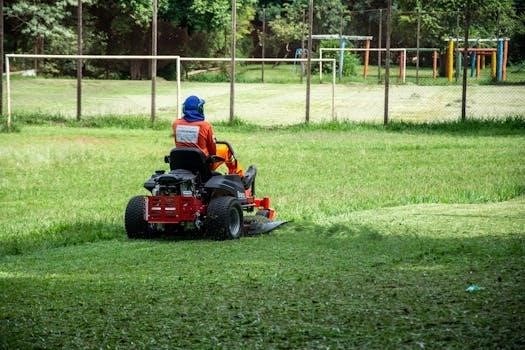
owner’s manual husqvarna riding mower
Husqvarna riding mower owner’s manuals serve as essential guides for safe operation and maintenance. These documents, available in PDF format, provide detailed instructions, ensuring users understand their equipment fully. Accessing the correct manual for your specific model is crucial for effective use and longevity, as there are many models.
Importance of the Owner’s Manual
The owner’s manual for a Husqvarna riding mower is paramount for ensuring safe and efficient operation. It is not merely a collection of instructions but a comprehensive resource that outlines critical information to protect both the user and the equipment. Before operating any riding mower, it is essential to carefully read, understand, and follow all the instructions contained within the manual, thereby minimizing the risk of accidents and injuries. These manuals detail important safety practices, including warnings about the potential for serious harm, particularly to children. The manual provides guidance on proper operating procedures, maintenance schedules, and troubleshooting tips, all of which contribute to the mower’s longevity and performance. Furthermore, failure to adhere to the manual’s guidelines may void the product’s warranty. The manual serves as a reference point for understanding the machine’s capabilities and limitations, thereby promoting responsible and safe usage. By consulting the owner’s manual, users can avoid operational errors and extend the service life of their Husqvarna riding mower, making it a valuable tool for any owner.

Finding Your Specific Manual
Locating the precise owner’s manual for your Husqvarna riding mower is crucial, as each model may have unique specifications and operating procedures. The most reliable place to start is the official Husqvarna website, where a vast library of manuals is available for download in PDF format. Identifying your mower’s specific model number is the first step in this process. This number is usually found on a label affixed to the mower, often near the engine or under the seat. Once you have the model number, you can use the website’s search function to find the corresponding manual. Additionally, several third-party websites also host Husqvarna manuals, though it’s advisable to prioritize the official source to ensure accuracy and avoid outdated documents. Some online retailers that sell Husqvarna products also provide access to manuals. If you’re unable to locate your manual online, contacting Husqvarna customer service directly via their toll-free number or through their website can provide assistance. Be prepared to provide your mower’s model number and possibly the serial number when requesting support. Remember, having the correct manual ensures you have the right information for safe and effective operation.

Safety Information in Husqvarna Riding Mower Manuals
Husqvarna manuals emphasize safety, warning users about potential dangers. They highlight the risk of amputation and thrown objects. Reading and understanding these safety instructions is crucial for preventing serious injury or death. These manuals prioritize operator safety.
General Safety Practices
Prior to operating any Husqvarna riding mower, it’s imperative to thoroughly read and comprehend all instructions provided in the owner’s manual. This includes understanding the machine’s capabilities, limitations, and safety features. Never operate the mower if you are not fully aware of its controls and how to use them safely. It’s essential to ensure that all safety devices are in place and functioning correctly before each use. Avoid operating the mower if you are tired, under the influence of drugs or alcohol, or otherwise impaired. Keep bystanders, especially children and pets, at a safe distance during operation. Wear appropriate personal protective equipment (PPE) such as eye protection, sturdy footwear, and hearing protection. Be aware of your surroundings and avoid obstacles like rocks, holes, and uneven terrain; Never attempt to clear clogs or make repairs while the engine is running. Always turn off the engine and remove the key before leaving the operator’s seat or performing any maintenance. Store the mower in a safe and secure location when it is not in use, away from children and unauthorized persons.
Specific Warnings and Cautions
Husqvarna riding mower manuals contain specific warnings and cautions that must be heeded to prevent serious injury. One common warning pertains to the mower’s cutting blades, which are capable of causing severe amputations. Always keep hands and feet away from the blades while the engine is running, and never attempt to reach under the deck while the mower is in operation. Be particularly careful when operating on slopes or near drop-offs, as the mower can tip over easily if not handled with care. Never carry passengers, as the mower is designed for single-person operation. Be aware that hot exhaust and engine parts can cause burns, so avoid touching them. Ensure the mower is free of grass, leaves, or other debris that could catch fire when coming in contact with hot parts. Avoid operating the mower in wet or slippery conditions to prevent loss of control. Do not operate the mower without proper guards and shields in place. Refuel the mower outdoors in a well-ventilated area, and never while the engine is running or hot. Always store gasoline in approved containers, away from heat sources. The use of gasoline with more than 10% ethanol will void the product warranty.

Operating Instructions in Husqvarna Riding Mower Manuals
These manuals provide crucial guidance on safely operating your Husqvarna riding mower. They detail starting and stopping procedures, proper use of controls, and, if applicable, how to purge the system for optimal performance, ensuring correct and safe use.
Starting and Stopping Procedures
The Husqvarna riding mower owner’s manual provides specific instructions for starting and stopping your machine, which are crucial for safe and effective operation. Before starting, always ensure the area is clear of obstacles and bystanders. The manual will typically detail how to engage the parking brake, position the mower deck, and correctly operate the ignition system. Understanding the proper sequence is essential to avoid damage to the mower or potential injury. Most Husqvarna models require the operator to be in the seat to activate the starting sequence. Once the engine is running, pay close attention to the operating instructions for speed and blade engagement. Stopping the mower also requires a specific procedure, often involving disengaging the blades and allowing the engine to idle before turning off the ignition. The manuals emphasize that following these steps ensures the longevity of the equipment and the safety of the operator. Always refer to your specific model’s manual for the exact sequence as procedures may vary between models. Never leave the mower unattended while running. After stopping, it is important to engage the parking brake to prevent accidental movement.
Operating the Mower Controls
Husqvarna riding mower manuals provide detailed guidance on operating various controls, ensuring safe and efficient mowing. Familiarizing yourself with the location and function of each control is paramount before operation. The manuals typically cover the throttle, which regulates engine speed, and the blade engagement lever or switch, which controls the cutting mechanism. Understanding how to use the motion control levers is crucial for maneuvering the mower effectively, including forward, reverse, and turning. The steering wheel and its sensitivity are also explained in detail. Some models may also feature a cruise control option, described in detail within the manual. The cutting height adjustment lever or dial is another important control, affecting the height of the grass cut. The manual will provide instructions on how to select the appropriate cutting height. The operator should practice using the controls in a safe area until they are comfortable with the mower’s handling. The manual also addresses the use of the parking brake and other safety features. Always adhere to the directions in the manual to prevent accidents or damage to the equipment.
Purging the System (if applicable)
Some Husqvarna riding mowers, particularly those with separate pumps and wheel motors, may require a purging procedure before initial use or after certain maintenance tasks. This process, detailed in the owner’s manual, ensures that hydraulic systems are free of air, which can impede proper operation. The manual provides clear instructions on how to activate the freewheel function, usually by turning bypass valves on each pump. It emphasizes the importance of filling the oil reservoir to the specifications given in the manual before starting the purge. The purging procedure itself typically involves moving the motion control levers to a neutral position, then moving them forward a short distance, repeating this several times. This action helps to circulate the fluid and remove trapped air. After the purge, it is critical to return the motion control levers to the neutral position. The manual might also recommend contacting an authorized service center for assistance if the procedure is unclear or if problems persist. This process is crucial for ensuring smooth and reliable performance of the mower’s hydraulic components.

Maintenance and Troubleshooting in Husqvarna Riding Mower Manuals
These manuals outline essential maintenance for optimal mower performance and longevity. They include guidance on regular tasks, troubleshooting common issues, and specific recommendations like wheel weight usage, crucial for safe and efficient operation of your Husqvarna mower.
Regular Maintenance Tasks
Husqvarna riding mower manuals emphasize the importance of consistent maintenance to ensure peak performance and extend the lifespan of your equipment. Key tasks include regularly checking and changing the engine oil, adhering to the specifications detailed in the manual, and ensuring the air filter is clean or replaced as needed. Inspecting the mower blades for sharpness and damage is crucial, and should be done frequently. The manual also advises on the correct procedure for lubricating moving parts, such as the steering components and wheel bearings, using the recommended lubricants. Additionally, maintaining proper tire pressure is vital for even cutting and safe operation. Always ensure the mower deck is free of grass clippings and other debris, which can cause overheating or damage. Checking and tightening all nuts and bolts is a regular task that prevents malfunctions and ensures the mower operates smoothly. Fuel system maintenance, such as checking fuel lines and the fuel filter, is also part of the necessary maintenance detailed in the manual. Lastly, refer to the manual for specific guidance on battery care and storage, especially during the off-season.
Troubleshooting Common Issues
Husqvarna riding mower manuals provide valuable troubleshooting information to help owners address common issues. If your mower fails to start, the manual advises checking the fuel level, spark plug, and battery connections first. For starting issues, it’s also essential to verify that the safety mechanisms, like the seat switch and blade engagement, are properly engaged. If the engine runs rough or stalls, the manual suggests examining the air filter for blockages and ensuring the carburetor is clean. Cutting problems such as uneven cuts can often be resolved by inspecting the blades for damage and verifying that the mower deck is correctly adjusted. If the mower is making unusual noises, the manual recommends checking for loose parts, worn bearings, or debris lodged in the mower deck. For hydro static transmission problems, the manual may instruct you to verify the oil levels and check for any leaks. If the mower is hard to steer, look for worn steering components as outlined in the manual. Always consult your specific model’s manual for detailed step-by-step diagnostic instructions, and remember to disconnect the spark plug before performing any hands-on troubleshooting to prevent accidental starting.
Wheel Weight Recommendations
Husqvarna riding mower owner’s manuals often include important information about wheel weight recommendations, which are crucial for maintaining optimal traction and stability, particularly when operating on uneven terrain or inclines. The manuals typically advise using the specific wheel weights or counterweights recommended by the manufacturer to avoid damaging the mower or compromising its performance. These weights are designed to improve the mower’s grip on the ground, reducing the risk of slippage, especially during uphill mowing or when using attachments that add extra weight. The manual usually specifies the appropriate weight amount and the method for attaching them securely to the wheels. Ignoring these recommendations can lead to poor handling, increased wear on the mower components, and potential safety hazards. The use of incorrect weights can cause undue stress on the mower’s axle and transmission. Additionally, the manual may advise adjusting the tire pressure according to the recommended wheel weight to achieve the best results. Always verify that the wheel weights are properly installed and are not obstructing any moving parts. Refer to your specific Husqvarna model’s manual for precise guidelines on wheel weights and their proper use.

Leave a Reply
You must be logged in to post a comment.